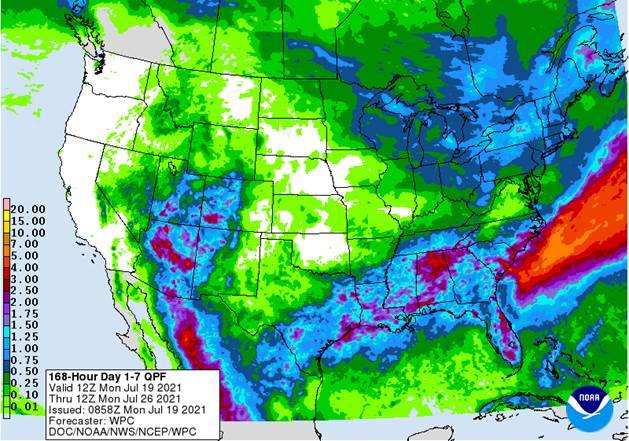PDF Attached
Calls:
Corn
2-5 higher, beans steady-higher, and wheat 4-7 higher Chicago & KC, 6-12 Minneapolis Spring Wheat.
Choppy
two-sided trade in CBOT futures. WTI was sharply lower after OPEC and its allies agreed to boost output. USD was up 15 points as of 1:30 PM CT. Virus concerns impacted other global markets. US equities were sharply lower. 30 year yield traded at 1.81%,
lowest since February 1. US spring wheat conditions declined by a more than expected 4 points to only 11 percent good/excellent. Corn was unchanged at 65 percent and soybeans rose one point to 60 percent. 73 percent of the US winter wheat had been harvested,
up from 59 percent last week and one point below average.
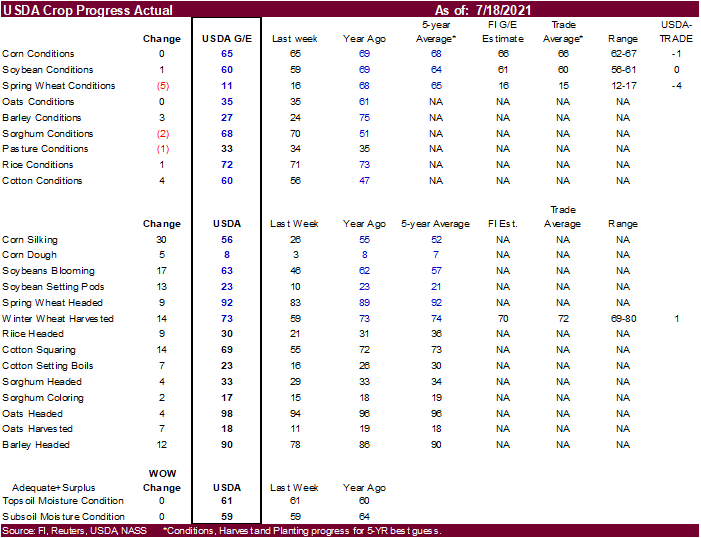
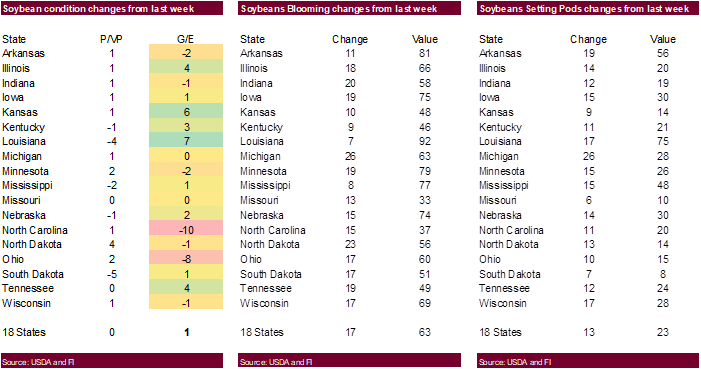
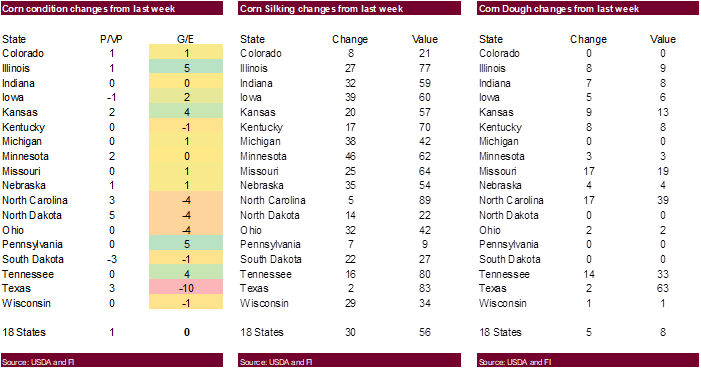

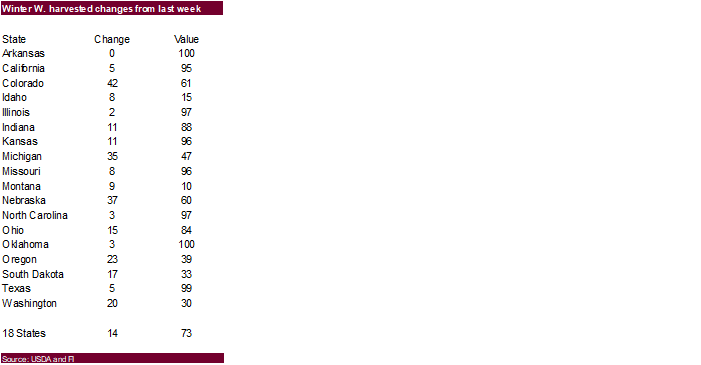
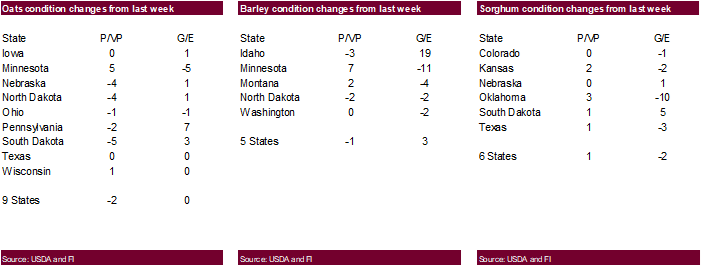
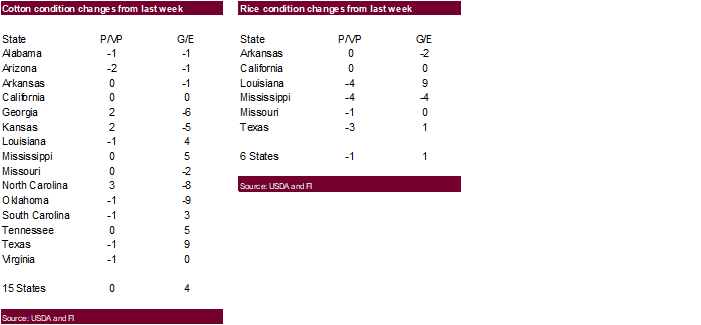

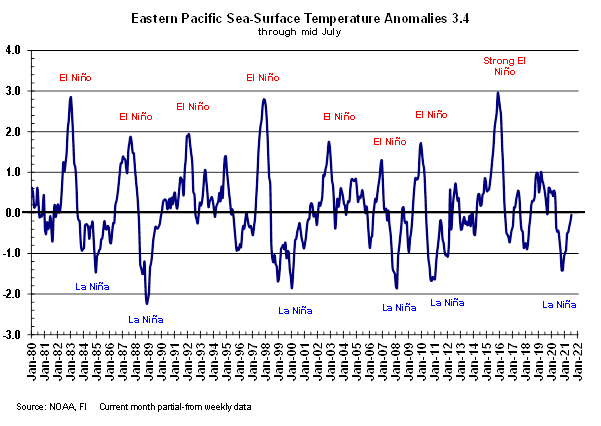
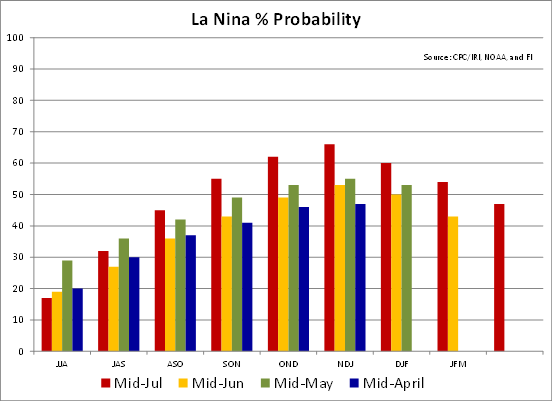
WORLD
WEATHER INC.
CHANGES
OVERNIGHT
-
Frost
and freezes occurred this morning from Rio Grande do Sul to southern Mato Grosso do Sul, Sao Paulo and a few southernmost Minas Gerais locations.
o
Most hard freezes were in the wheat production areas of Parana where there may have been some permanent damage depending on the stage of crop development
o
Frost in sugarcane, citrus and coffee areas should not have been serious enough to induce permanent crop damage
-
Tropical
Storm Cempaka was located 103 miles southwest of Hong Kong at 21.1 north, 112.9 east moving west northwesterly at 3 mph and producing wind speeds to 58 mph
o
The storm will eventually move inland over Guangdong, China Tuesday and heavy rain from the storm is expected through at least Thursday resulting in some flood damage to rice and personal property
-
Tropical
Storm In-Fa was located 259 miles southeast of Okinawa or 615 miles east southeast of Taipei near 24.1 north, 131.4 east moving northwesterly at 3 mph and producing maximum sustained wind speeds of 58 mph.
o
In-Fa is expected to become a typhoon Tuesday and it will pass to the immediate north of Taipei, Taiwan Friday
-
Heavy
rain and flooding along with some strong wind may impact northern parts of the island and some computer forecast models have the storm moving directly across northern Taiwan -
A
close watch on the storm is warranted because of the potential for devastating floods and wind
o
Landfall will ultimately end up over Fujian and/or southern Zhejiang where torrential rainfall is possible along with very strong wind speeds
-
Damage
to crops and property are expected, although the details of that will be known later this week as the storm moves closer to land
MOST
IMPORTANT WEATHER OF THE DAY
-
Weekend
U.S. weather was dry from the eastern Dakotas, Minnesota and Wisconsin into northern Illinois, northern Missouri and parts of northeastern Kansas
o
Rain fell in most other Midwest locations and in the Delta with some heavy rain noted
-
Rain
totals ranged from 1.00 to 2.00 inches with local amounts over 3.00 inches
o
Rain the U.S. southeastern states was more erratic with local totals of 1.00 to 2.00 inches in parts of Alabama, central South Carolina and from northeastern North Carolina into southeastern Virginia
-
However,
more than 6.00 inches fell along the Georgia/Alabama border
o
Scattered thunderstorms occurred in the Texas Panhandle and northern parts of West Texas with rainfall reaching 1.00 to 2.67 inches near the New Mexico border
o
Dry weather occurred in most of the far western U.S.; including the Pacific Northwest, California, the Great Basin and much of the southwestern desert region
o
Temperatures were seasonably warm to hot in many areas in the western United States with Montana temperatures in the 90s to 104 degrees Fahrenheit
-
Other
temperatures over 100 occurred in the southwestern desert region with extremes to 112 -
U.S.
weather through Thursday will not generate enough rain to counter evaporation in the west coast states, the Pacific Northwest, the northern and central Plains or much of the Midwest
o
These areas will not be totally dry, but the showers that occur will be too brief and light to counter evaporative moisture losses
o
Temperatures will be most anomalously hot in the northern Plains where Montana will reach 110 Fahrenheit and possibly a little hotter
o
Warmer than usual conditions will also occur in the interior western states
o
Temperatures will be more seasonable in other areas with readings in the central and southern Plains and western Corn Belt gradually trending a little hotter with 90-degree highs by late this week
-
U.S.
Midwest rainfall will increase Friday through Sunday from central and eastern Minnesota, Wisconsin and parts of Michigan to the Ohio River Valley
o
Rainfall of 0.30 to 0.90 inch and local totals of 1.00 to 2.00 inches will be possible
o
Scattered showers and thunderstorms will also occur in the Delta during this period of time with more isolated showers in the southeastern states
-
Daily
rainfall in these areas will vary from 0.20 to 0.75 inch with locally more
o
Net drying will continue elsewhere; including most of the western Corn Belt
-
U.S.
temperature anomalies will be warmer than usual during both this week and next week in the northern Plains, upper Midwest and western United States while temperatures will be more seasonable elsewhere
o
Temperatures will be hottest early to mid-week this week and again starting in Montana next Sunday and advancing across the northern Plains during the first half of next week
-
Temperature
extremes in the 90s to 110 degrees will occur during both of these periods of excessive heat with Montana and the western Dakotas most impacted by extremes above 100.
-
Eastern
U.S. Midwest temperatures will trend warmer at times this week and next week, but there will be some brief periods of cooling keeping the heat from becoming excessive
o
The warmer bouts of weather will prove very helpful to corn and soybean production areas that have abundant soil moisture since it will stimulate more aggressive crop development and help ensure the best yield potentials.
-
Monsoonal
precipitation will increase over the next ten days from Arizona and western New Mexico into Utah, eastern Nevada and Colorado -
The
bottom line for U.S. crop areas will remain one of concern over the next two weeks over production potentials for spring summer crops in the Dakotas, Montana and eventually in parts of Nebraska, Iowa, Minnesota and Wisconsin. Net drying is also expected in
a part of Kansas, Missouri and parts of western Illinois. West Texas crop areas will experience a good mix of weather for improved summer crop conditions. The Delta may get a little more rain than desired, but no serious harm will come to crops in the region.
With that said, the Delta needs to dry down for early corn maturation and harvesting. The Southeastern states will experience a good mix of weather supporting aggressive crop development, although Virginia may dry out. Monsoonal rainfall will increase during
the week from Arizona and western New Mexico to Utah, southern and eastern Nevada and Colorado. The Pacific Coast states will continue very dry and the region’s forest fires will continue to burn.
-
Canada’s
Prairies continued excessively dry during the weekend in southern and eastern crop areas, but rain fell in western and northern Alberta with amounts of 0.10 to 0.71 inch with a few amounts to 1.58 inches
o
Rainfall elsewhere was not significant and net drying occurred with widespread crop stress
o
Highest temperatures were in the 50s and 60s Fahrenheit occurred in northwestern Alberta while in the 90s from southeastern Alberta through much of central and southern Saskatchewan into central and southern Manitoba
o
Lowest morning temperatures slipped to the upper 40s in the Peace River Region in northwestern Alberta
-
Manitoba
and a few northeastern Saskatchewan, Canada locations may receive some rain briefly during mid-week this week and again late this week and possibly a little later next week, as well
o
Resulting rainfall is not likely to be great enough to seriously improve crop or field conditions, but any rain would be better than none
o
Temperatures will be warmer than usual throughout the coming two weeks except in northwestern Alberta where additional rain is expected periodically which will help hold temperatures down for a little while.
-
Ontario
and Quebec, Canada will receive near to above average rainfall this week and lighter rain next week while temperatures are close to normal with a slight cooler bias -
Europe
has been too wet so far this month in the central and northeastern parts of the continent, but rain during the weekend was diminishing in this region setting the stage for an end of winter grain and oilseed quality declines at least for a while
o
Harvest delays continued during the weekend, but change is coming
-
Europe
will see much less rain in this coming week offering improvement for grain quality and harvest progress from eastern France to Poland where it has been wettest
o
Rain may increase again in France and Germany at the end of this month
o
Even though this week will be drier biased there will still be some rain late this week into early next week that may set back the drying trend briefly
-
Drought
relief occurred in parts of the Europe’s western Balkan region during the weekend with rainfall of 0.57 to 3.27 inches of rain resulting
o
Not all areas received sufficient rain to ease long term dryness, but a significant amount of relief occurred in other areas
o
Additional rain will fall in a part of this region this week with 0.50 to 1.50 inches of rain expected throughout southeastern Europe
-
CIS
rain during the weekend was a little sporadic, but showers were noted in many areas north of Russia’s Southern Region, Ukraine and Kazakhstan
o
The moisture was welcome in western Russia where net drying occurred in the past week, but more rain is needed
-
CIS
rainfall this week will be most significant and frequent from western Ukraine to the Volga Vyatsk and Ural Mountain region where 1.00 to 2.00 inches and local totals over 3.00 inches may occur this week
o
Net drying is expected in northwestern Russia, the Baltic States, Belarus and many areas from Russia’s Southern Region into Kazakhstan
o
A boost in rainfall should occur during mid- to late-week next week in northwestern Russia, the Baltic States and Belarus
-
Drying
will continue from southern parts of Russia’s Southern region into Kazakhstan -
The
bottom line for the CIS will be one of good crop development potential from western and central Ukraine to the Ural Mountain region and Volga Vyatsk. Crop conditions will also remain mostly good in Russia’s eastern New Lands. In the meantime, net drying from
Russia’s Southern Region into Kazakhstan will be stressful for unirrigated summer crops which may feel some downward pressure on production. Moisture stress in northwestern Russia may linger for a while through the coming week to ten days, but relief should
come shortly thereafter. -
China
weekend rainfall brought back excessive rain to Anhui, northern Jiangxi, eastern Henan, western Shandong and parts of Shanxi. Excessive rain also occurred in interior eastern Sichuan and areas southward into Guizhou and eastern Guangxi
o
All of these areas reported rainfall of 3.50 to 6.00 inches with local totals to 14.29 inches in western Anhui and nearly 11.14 inches in western Shanxi.
o
Rainfall elsewhere was much lighter with many areas of net drying
o
Highest weekend temperatures were in the upper 80s and lower 90s in much of the nation, but in the upper 90s in the interior south
-
Rain
is expected in most of China during the next two weeks
o
This will keep some areas a little too wet and others more favorably moist to support the best production potential
o
Tropical Storm Cempaka was expected to drift into Guangdong Tuesday and last through Thursday with rainfall of more than 10.00 inches of rain resulting
-
Tropical
Storm In-Fa will bring torrential rain, flooding and strong wind to Taiwan and southeastern China
o
The storm may impact Taiwan and both Fujian and Zhejiang, China during the latter part of this week
-
Some
rice and sugarcane damage is expected -
Xinjiang,
China weekend rainfall was mostly confined to areas near the mountains
o
Temperatures were a little milder than usual with highs in the northeast in the 80s and lower 90s Fahrenheit while in the lower to middle 90s in the southwest
-
Xinjiang
China degree day accumulations continue behind normal
o
Warming is needed
-
Hurricane
Felicia and Topical Storm Guillermo were in the eastern Pacific Ocean and both were moving away from Mexico and expected to remain south of Hawaii
o
No land impact is expected from either of these storms
-
India
weather during the weekend was wettest from Bangladesh to Uttar Pradesh and in portions of the interior south
o
Amounts were highly varied with most areas reporting 1.00 to 3.00 inches in the east while interior southern areas reported amounts mostly under 1.00 inch
-
Local
amounts to more than 5.00 inches occurred near the Nepal border
o
Coastal areas were wettest along the middle west coast where rainfall of 5.00 to more than 13.50 inches resulted
o
Drying occurred from Odisha through southwestern Madhya Pradesh to parts of Gujarat and western parts of Rajasthan
-
Much
of Pakistan was also dry along with eastern Maharashtra -
India
rainfall over the next two weeks will slowly increase bringing rain to most of the nation and improve crop and field conditions over time
o
There is some concern over net drying in the far south and extreme northwest, but most other areas will receive sufficient rain to bolster soil moisture and support improving crop development and long term moisture supply
-
Brazil
weekend precipitation was greatest from southern Mato Grosso do Sul to southern Sao Paulo and Parana with rainfall of 0.20 to 0.84 inch and local totals to 1.18 inches
o
Dry weather prevailed elsewhere
o
Norther Brazil was warm while frost and freezes impacted the far south
-
Southern
Brazil will continue cool early to mid-week this week
o
Frost and freezes will impact wheat areas from Parana into Rio Grande do Sul
-
Winter
wheat could be temporarily impacted from Parana to Rio Grande do Sul -
A
close watch on temperature extremes is warranted, though
o
Soft frost may reach a few pockets in the traditionally coolest areas of Sul de Minas, but no crop damage is expected in the key coffee, citrus or sugarcane production areas
-
Brazil
will be drier biased during the next ten days -
Argentina
weather will be mostly dry over the next ten days
o
Some winter wheat would welcome rain especially in the west, but crop conditions are much better than last year at this time
o
Crops are mostly semi-dormant right now
o
No meaningful precipitation fell during the weekend
-
West-central
Africa rainfall during the weekend brought some needed moisture to parts of Ivory Coast and Ghana, although some of the rainfall was not enough to counter evaporation
o
Western Ghana and western Ivory Coast reported 0.40 to more than 2.00 inches of rain with one Ivory Coast location reporting 2.83 inches
-
Ivory
Coast and Ghana rainfall will be restricted over the next couple of weeks
o
Seasonal rainfall should return normally in September, but August rainfall will be lighter than usual
-
Other
areas in West Africa will see a better distribution of rain -
East-central
Africa rainfall will continue favorable for coffee and cocoa, although some areas in Uganda and Kenya may receive less than usual rainfall
o
Ethiopia rainfall is expected to continue improving after a slow start to the rainy season
-
Southern
Oscillation Index has reached back about +12.32 and it is expected to remain strongly positive this week while slowly leveling off after a strong rising trend since June 22 when the index was -3.36 -
Southeast
Asia rainfall recently and that which is expected in the next two weeks will continue somewhat erratic
o
Vietnam, Laos, Cambodia and Philippines will see the greatest rainfall
o
Sumatra and Java, Indonesia and Peninsular Malaysia may experience less than usual rainfall for a while
o
Thailand will also experience less than usual rainfall, although there has been some beneficial moisture recently
-
Australia
weather in the first half of July has been ideal for improving winter wheat, barley and canola establishment in much of the nation
o
Weekend rainfall was greatest from South Australia into Victoria and New South Wales where 0.30 to 0.71 inch occurred with local totals of 1.00 to 2.60 inches in Victoria
o
Some additional rain is still needed in South Australia, northwestern Victoria and from western New South Wales to western crop areas of Queensland
-
South
Africa has been cold during the past week with waves of rain in the southwest
o
Weekend rainfall was still cool, but rain ended in many areas
o
The moisture has been good for future wheat development
o
Dryness remains in some of the unirrigated eastern wheat production areas
o
Some warming is expected over the coming week, but the precipitation anomalies will prevail
-
Mexico
weather has improved with increased rainfall in the south and west parts of the nation
o
Drought conditions are waning and crops are performing better
o
Dryness remains in Chihuahua and northeastern parts of the nation
o
Weather over the next ten days will offer some relief, but more rain will be needed in the drier areas
-
Central
America rainfall has been plentiful and will remain that way except in Honduras where recent rainfall has been lighter and more sporadic than usual
o
Nicaragua has received frequent bouts of rain this month easing long term dryness, but more may be needed in some locations
-
New
Zealand rainfall during the coming week will be near to above normal in North Island and western portions of South Island while below average in eastern South Island
o
Temperatures will be seasonable
Source:
World Weather Inc.
Bloomberg
Ag Calendar
Tuesday,
July 20:
- China
customs to publish by-country breakdown for imports of farm goods including soy - New
Zealand global dairy trade auction - EU
weekly grain, oilseed import and export data - HOLIDAY:
Malaysia, Indonesia, Singapore
Wednesday,
July 21:
- EIA
weekly U.S. ethanol inventories, production - Malaysia
July 1-20 palm oil export data - HOLIDAY:
India
Thursday,
July 22:
- USDA
weekly crop net-export sales for corn, soybeans, wheat, cotton, pork, beef, 8:30am - USDA
to release world supply-demand outlook for orange and its juice - Port
of Rouen data on French grain exports - USDA
total milk, red meat production - U.S.
cold storage data – pork, beef, poultry - HOLIDAY:
Japan
Friday,
July 23:
- ICE
Futures Europe weekly commitments of traders report (6:30pm London) - CFTC
commitments of traders weekly report on positions for various U.S. futures and options, 3:30pm - FranceAgriMer
weekly update on crop conditions - U.S.
cattle on feed, poultry slaughter, cattle inventory - HOLIDAY:
Japan
Source:
Bloomberg and FI
Selected
China commodity imports
|
Commodity |
June |
% |
YTD |
% |
|
Corn |
3.75 |
305 |
15.3 |
318.5 |
|
Wheat |
750,000 |
-17 |
5.37 |
60.1 |
|
Barley |
1 |
100 |
5.65 |
131.1 |
|
Sorghum |
1.1 |
61 |
4.79 |
169.4 |
|
Pork |
340,000 |
-13.7 |
2.3 |
8.5 |
|
Sugar |
420,000 |
1.7 |
2.03 |
63.3 |
|
Wheat |
490,626 |
versus |
275000-550000 |
range |
|
Corn |
1,000,512 |
versus |
800000-1300000 |
range |
|
Soybeans |
143,934 |
versus |
100000-300000 |
range |

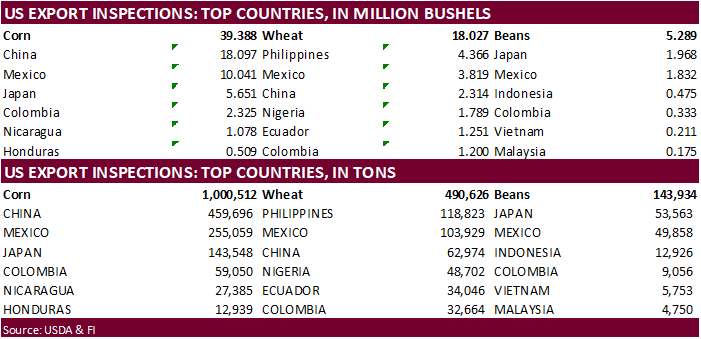
GRAINS
INSPECTED AND/OR WEIGHED FOR EXPORT
REPORTED IN WEEK ENDING JUL 08, 2021
— METRIC TONS —
————————————————————————-
CURRENT PREVIOUS
———–
WEEK ENDING ———- MARKET YEAR MARKET YEAR
GRAIN 07/08/2021 07/01/2021 07/09/2020 TO DATE TO DATE
BARLEY
0 744 0 1,919 367
CORN
993,974 1,236,243 917,968 59,146,024 35,297,236
FLAXSEED
0 0 24 0 317
MIXED
24 0 0 24 0
OATS
0 100 0 100 400
RYE
0 0 0 0 0
SORGHUM
73,294 4,349 71,755 6,556,602 4,141,859
SOYBEANS
200,933 208,136 483,429 57,655,465 37,866,691
SUNFLOWER
0 0 0 240 0
WHEAT
424,327 361,811 659,727 2,323,828 3,074,575
Total
1,692,552 1,811,383 2,132,903 125,684,202 80,381,445
————————————————————————-
CROP
MARKETING YEARS BEGIN JUNE 1 FOR WHEAT, RYE, OATS, BARLEY AND
FLAXSEED;
SEPTEMBER 1 FOR CORN, SORGHUM, SOYBEANS AND SUNFLOWER SEEDS.
INCLUDES
WATERWAY SHIPMENTS TO CANADA.
US
NAHB Housing Market Index Jul: 80 (est 82; prev 81)
US
NAHB Index Of Prospective Buyers Jul: 65 (prev 71)
US
Fed accepts $860.468 bln in daily reverse repo operation, awards at 0.05% to 71 bidders – NY Fed.
Corn
- Corn
traded two-sided, ending unchanged to 1.0 cent higher on strength in wheat and dry conditions across the far northwestern Corn Bely. A steep decline in US energy prices and rally in the USD limited gains. US WCB will trend drier through Thursday.
- Corn
conditions were unchanged but on a weighted basis improved slightly. We lifted out August yield by a tenth of a percent to 177.9 bu/ac.
- US
weather through Thursday will be dry in the west coast states, the Pacific Northwest, the northern and central Plains or much of the Midwest. Temperatures will be above normal in the northern Plains where Montana will reach 110 Fahrenheit. U.S. Midwest
rainfall (0.3-2.00) will increase Friday through Sunday from central and eastern Minnesota, Wisconsin and parts of Michigan to the Ohio River Valley.
- USDA
US corn export inspections as of July 15, 2021 were 1,000,512 tons, within a range of trade expectations, below 1,002,342 tons previous week and compares to 1,220,792 tons year ago. Major countries included China for 459,696 tons, Mexico for 255,059 tons,
and Japan for 143,548 tons. - Two
dams in north China’s Inner Mongolia Autonomous Region collapsed from heavy rain on Sunday. No casualties were reported. Crops on the other hands were likely impacted. Meanwhile the heavy rain affected Heilongjiang, Jilin, and Inner Mongolia. We heard
thousands of hectares of crops were wiped out, but that could take some time to get actual figures. Rain is expected in most of China during the next two weeks that will keep some areas a little too wet. A tropical storm will move into Guangdong Tuesday
and last through Thursday with rainfall of more than 10.00 inches resulting.
- Germany
reported a 3rd case of ASF in the eastern state of Brandenburg. A couple cases of ASF were discovered in Germany last week, 2 at small farms.
- China
hog prices may extend their rebound according to the National Development and Reform Commission. They said, “the number of hogs slaughtered in July and August is seen declining to some extent.” We also think a ban on Germany pork imports would also drive
up prices. - China
plans to increase pork reserves on July 21 by buying from the domestic market.
- China
reported June corn imports at 3.75 million tons and year to date imports at 15.3 million (up 318% from previous period in 2020).
- Ghana
Confirms Bird-Flu. Outbreak With 600,000 Animals at Risk (Bloomberg) - Brazil
harvested 30 percent of their Brazil corn crop as of July 15 for the center south fields, up 10 points from previous week, and below 43% year ago.
Export
developments.
Jordan
seeks 120,000 tons of feed barley on July 28 for Nov/Dec shipment.
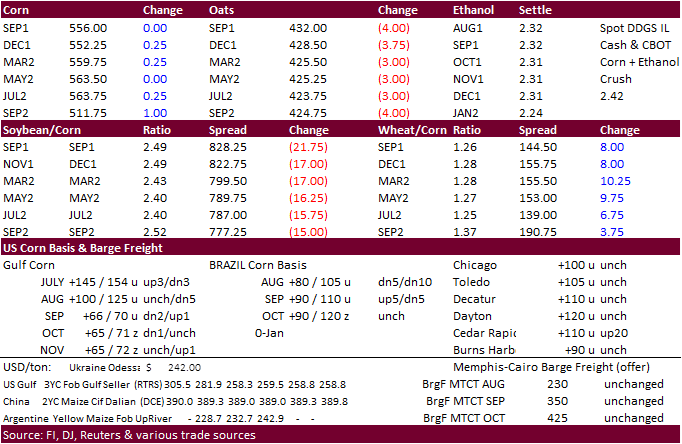
Updated
07/13/21
September
corn is seen is a$4.75-$6.25 range
December
corn is seen in a $4.25-$6.00 range.
-
The
soybean complex traded in a choppy two-sided range. August soybeans traded back below their 50-day MA of 14.7325. Soybean meal was higher mid-session but broke after soybean oil and soybeans grinded lower. Soybean oil was lower on sharply lower crude oil
after OPEC agreed to increase production and Argentina amending their biodiesel blend rates. The decrease in biodiesel use in Argentina may boost soybean oil exports over the medium term. Argentina exported a 5.36 million tonnes of soyoil last year.
-
US
soybean conditions increased one point to 60 percent, as expected. We left our US soybean yield unchanged at 50.9 bu/ac.
-
November
Canadian canola fell 19.70 to 898.10/ton. -
US
soybean meal basis firmed $2/short ton in Chicago, Decatur, IL, Morristown, IN, KC, Missouri, and Fostoria, Ohio (all rail). Mankato truck was up $3.00 to 15 under.
- USDA
US soybean export inspections as of July 15, 2021 were 143,934 tons, within a range of trade expectations, below 201,129 tons previous week and compares to 454,719 tons year ago. Major countries included Japan for 53,563 tons, Mexico for 49,858 tons, and Indonesia
for 12,926 tons. -
China
futures rallied 1.5 to 1.9% for the soybean complex and palm oil. -
Malaysian
palm futures touched a 6-week high. The Southern Peninsula Palm Oil Millers’ Association estimated palm oil production during July 1-15 fell by 3.5% from the same period in June.
-
APK-Inform
reported sunoil export bid prices had increased about $120/ton from the previous week to $1,190-$1,230 per ton on a free-on-board basis from Black Sea ports with for July-August.
-
US
crop progress and inspections due out later. We look for an improvement in corn and soybeans.
- China
cash crush margins were last positive 8 cents on our analysis, up from negative 4 cents late last week.
- On
Friday Argentina signed into law a revision to biofuel mandates. They took biodiesel down 5 percentage points to 5 percent and left ethanol unchanged at 12 percent (6 percent sugar cane and 6 percent corn ethanol). The Energy AgMin has the right to reduce
the biodiesel blend rate lower to 3% under special economic circumstances. The regulation is valid until 2030.
- USDA
seeks 14,500 tons of packaged vegetable oil on July 20. 10,000 is for preposition.
- South
Korea’s Agro-Fisheries & Food Trade Corp. seeks around 7,600 tons of GMO-free soybeans on July 21 for arrival in South Korea between Aug. 20 and Oct. 20.
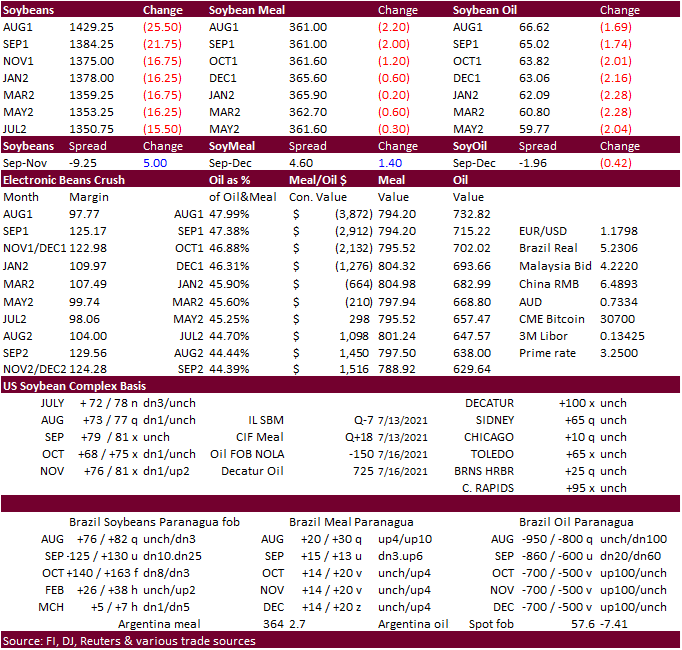
Updated
7/15/21
August
soybeans are seen in a $13.25-$15.25 range; November $11.75-$15.00
August
soybean meal – $330-$410; December $320-$425
August
soybean oil – 64.50-70.00; December 46-67 cent range
- Wheat
ended higher (2-month high hit in Chicago). US weather concerns were noted. Hot and dry conditions across parts of the Black Sea region added to the bullish undertone. Kazakhstan plans to curb grain exports.
- US
spring wheat ratings dropped by a more than expected 5 points (trade looking for down 1) to only 11 points G/E. We adjusted lower our spring and durum yield, near USDA’s July projections.
- Note
we have an upward price range of $9.50 for MN September wheat, and look for a higher open tonight. 4-7 higher Chicago & KC, 6-12 Minneapolis spring wheat. - USD
was up 15 points around 1:30 pm CT. - USDA
US all-wheat export inspections as of July 15, 2021 were 490,626 tons, within a range of trade expectations, above 427,819 tons previous week and compares to 512,305 tons year ago. Major countries included Philippines for 118,823 tons, Mexico for 103,929 tons,
and China for 62,974 tons. - Kazakhstan
plans to limit exports of barley and wheat used for animal feeds from August 15 and completely ban exports of rye for six months amid feed shortages caused by drought across Central Asia. (Reuters) - Russian
wheat export prices rose last week by about $3/ton from the previous week to $241/ton, according to IKAR. SovEcon showed a $5/ton increase to $239/ton.
- Russian
wheat shipments so far this season (June 1 start) fell 37% from previous season to 400,700 tons as of July 15.
- Ukraine
grain exports reached 1 million tons since June 1, including 292,000 tons of wheat, 207,000 tons of barley and 498,000 tons of corn. - December
Paris wheat was up 0.25 at 216.25 euros.
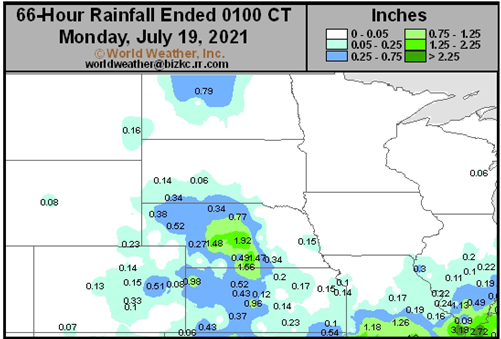
- Iranian
state agency the Government Trading Corporation (GTC) made no purchase for 60,000 tonnes of milling wheat which closed last week. Shipment was sought in August and September.
- Bangladesh
saw offers for 50,000 tons of wheat (335.00/ton CIF lowest). - The
Philippines bought 50,000 tons of Black Sea wheat at $287/ton c&f for shipment between September 4 and September 24.
- Ethiopia
seeks 400,000 tons of wheat on July 19.
- Pakistan’s
TCP seeks 500,000 tons of wheat on July 27. 200,000 tons are for August shipment, and 300,000 tons are for September shipment.
Rice/Other
- South
Korea seeks 91,216 tons of rice from China, the United States and Vietnam for arrival in South Korea between Oct. 31, 2021, and April 30, 2022.
- Bangladesh
seeks 50,000 tons of rice on July 18. - Mauritius
seeks 6,000 tons of white rice on July 27 for October through December shipment.

Updated
7/12/21
September Chicago wheat is seen in a $5.90-$7.00 range
September KC wheat is seen in a $5.60-$6.70
September MN wheat is seen in a $7.75-$9.50
Terry Reilly
Senior Commodity Analyst – Grain and Oilseeds
Futures International
One Lincoln Center
18 W 140 Butterfield Rd.
Oakbrook Terrace, Il. 60181
W: 312.604.1366
ICE IM:
treilly1
Skype: fi.treilly

Trading of futures, options, swaps and other derivatives is risky and is not suitable for all persons. All of these investment products are leveraged, and you can lose more than your initial deposit. Each investment product is offered
only to and from jurisdictions where solicitation and sale are lawful, and in accordance with applicable laws and regulations in such jurisdiction. The information provided here should not be relied upon as a substitute for independent research before making
your investment decisions. Futures International, LLC is merely providing this information for your general information and the information does not take into account any particular individual’s investment objectives, financial situation, or needs. All investors
should obtain advice based on their unique situation before making any investment decision. The contents of this communication and any attachments are for informational purposes only and under no circumstances should they be construed as an offer to buy or
sell, or a solicitation to buy or sell any future, option, swap or other derivative. The sources for the information and any opinions in this communication are believed to be reliable, but Futures International, LLC does not warrant or guarantee the accuracy
of such information or opinions. Futures International, LLC and its principals and employees may take positions different from any positions described in this communication. Past results are not necessarily indicative of future results.

